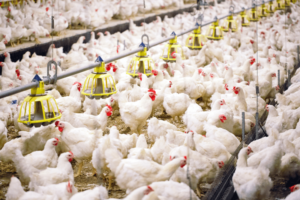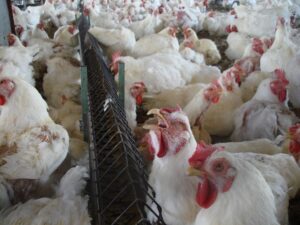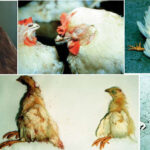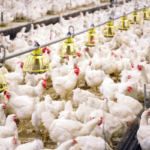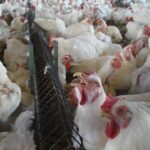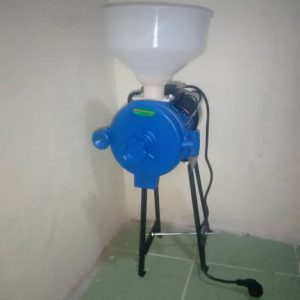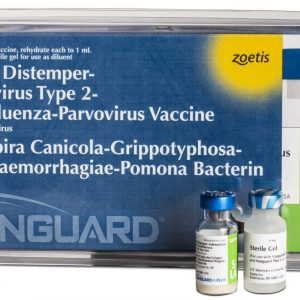Mycotoxicosis refers to a group of diseases caused by the effects of toxins produced by fungi/moulds. The major means of flock exposure to mycotoxin is feed but birds can also be exposed to toxins through contaminated litter material. Climates with high temperature and humidity e.g. Nigeria climate where grain is harvested with high water content usually have high incidence of mycotoxicosis challenge. High grain moisture content and poor storage conditions are major predisposing factors.
Several mycotoxins have been identified, and many of them are pathogenic (i.e. are capable of causing disease condition). Mycotoxins rarely act in isolation because moulds have the capacity to produce more than one type of toxin at a particular time thus making their effects additive or synergistic. Because of the immuno-suppressive effects (i.e. reduced ability to combat infections) of mycotoxicosis on birds, they usually become more prone to other disease agents especially bacterial and viral, also nutritional deficiencies. The disease condition is hard to recognize by an untrained eye. Even professionals must marry post mortem findings with laboratory feed analysis to arrive at a confirmatory diagnosis.
TYPES
There are different types of mycotoxicoses, some of these are;
Aflatoxicosis
Ochratoxicosis
Furatoxicosis
Ergotism
Citrinin Mycotoxicosis
The major organ of target during aflatoxicosis challenge is the liver but it can also affect immunogenic, digestive and hematopoietic functions. Since the primary organ of synthesis of fat- soluble vitamins (A,D,E and K) is the liver, the synthesis and transport of these vitamins are affected thereby resulting in deficiencies during episode of aflatoxicosis. Multiplication of moulds in cereals requires selenium and this element is also important for the production of hepatic lipases.
Ochratoxins are chiefly nephrotoxic (causes damage to the kidneys) but can also cause liver, immunogenic and bone marrow damage.
Furatoxicosis causes caustic injury to poultry. This might extend from the mouth down to other parts of the digestive tract. It usually causes feed refusal in birds. Lesions include necrosis and ulceration of the oral mucosa, reddening of the GI mucosa, mottling of the liver, atrophy of the spleen and other lymphoid organs, and visceral hemorrhages. In laying hens, decreased egg production can be accompanied by depression, recumbency, feed refusal, and cyanosis evident in the comb and wattles. Ducks and geese develop necrosis and pseudomembranous inflammation of the esophagus, proventriculus, and gizzard.
COMMON SIGNS OF MYTOSICOSIS
In-appetence
Poor growth rates
Reduced feed conversion efficiency
Weakness
General unthriftiness
Fall in egg production
Poor egg shell quality
Paralysis and in-coordination
Immuno-supression
Increased mortality
High Morbidity
Poor egg shell quality
Reduced fertility
Reduced Hatchabilty
POST-MORTEM LESIONS OF MYCOTOXICOSES
Depending on the type of mycotoxicosis, some of the lesions associated with mycotoxicosis include;
Damage to mucosae with which they come in contact.
Petechiation and larger haemorrhages in various tissues.
Livers may be enlarged and fatty or show bile retention
Gizard erosion or ulceration
Enteritis of variable degree may be seen.
Pale bone marrow.
Regression of the bursa of Fabricius.
DIAGNOSIS
Mycotoxicosis should be suspected when the signs and lesions are suggestive of feed intoxication. Grains and other feed materials with high moisture content encourage the growth and multiplication of molds during storage. Toxin exposure associated with consumption of a new batch of feed may result in subclinical or transient disease. Chronic or intermittent exposure can occur in regions where grain and feed ingredients are of poor quality or when feed storage is substandard or prolonged.
Confirmatory diagnosis involves detection and quantification of the specific toxin(s). This can be difficult because of the rapid and high-volume use of feed and ingredients in poultry operations. Feed and also birds that are sick or recently dead should be submitted for testing. Concurrent diseases can adversely affect production and should be considered. Sometimes, mycotoxicosis is suspected but not confirmed by feed analysis. In these situations, a complete laboratory evaluation can exclude other significant diseases.
For a comprehensive analysis, samples of the major feed ingredients (maize, soya, wheat, etc.) and the final feed should be submitted to the laboratory so that the contaminated material can be identified and discarded if level of contamination is terribly high. But in cases where the level of contamination is found to be low, toxin binder can be added as part of the feed additives used in the mill so as to bind the toxins in the feed rendering them harmless to the birds. Also the farmer might pick a fresh sample free of mycotoxin contamination of the indicted material, so as to greatly dilute the usage of the old material with the main objective of bringing down the level of toxin/mold in the finished feed to a level that is tolerable to poultry. Clean paper bags, properly labeled, are adequate. Sealed plastic or glass containers are appropriate only for short-term storage and transport, because feed and grain rapidly deteriorate in airtight containers.
Prevention and Treatment
Removal of the source of toxins is the most potent form of treatment available. Prolonged storage of feed materials should be discouraged but if this cannot be avoided, materials must be stored under good conditions. Screening feed ingredients at reception for molds is the best way to prevent exposure. Samples must be collected randomly from many bags so as to increase the chances of detection at this point. Outright rejection of materials with any trace of mouldy growth should be done. Addition of toxin binder to finished feed is also helpful. Increasing protein level in the feed until mortality reduces may also be beneficial. Administration of soluble vitamins and selenium (0.2 ppm), along with finely divided copper sulphate in the feed 1kg/ton for 7 days (where approved) has been proven to greatly alleviate the effects of mycotoxicoses on birds.
Feeds with high levels of fishmeals are particularly susceptible and should not be stored for more than 3 weeks. Pelletising feed may reduce fungal counts but does not affect toxins.
Organic acids (propionic acid, 500–1,500 ppm [0.5–1.5 g/kg]) are effective inhibitors, but the effectiveness may be reduced by the particle size of feed ingredients and the buffering effect of certain ingredients.
Other things that have been found to be helpful in the management of mycotoxicoses are;
Use of Nystatin
Use of liver tonic
Providing a solution containing Vitamin D, Calcium and phosphorus as supplements
Sorbent compounds such as hydrated sodium calcium aluminosilicate (HSCAS) effectively bind and prevent absorption of aflatoxin.



